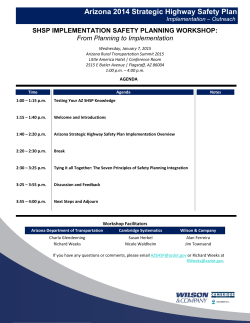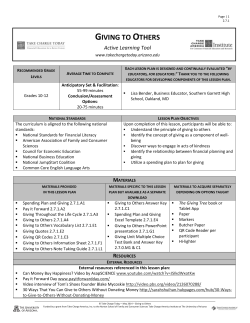
Savings Tools
Page | 22 2.4.3.A2 Savings Tools Total Points Earned 32 Total Points Possible Name Date Percentage Class Directions: Match the following savings tools with the correct definition. 1. ____ A depository institution account that is designated to hold money not spent on current consumption. 2. ____ An account at a depository institution that is used for a fixed period of time and allows restricted access to the funds deposited. 3. ____ An account at a depository institution that provides an easy method for withdrawing and depositing money. 4. ____ An account at a depository institution that usually has minimum balance requirements and tiered interest rates. A. Certificate of Deposit B. Checking Account C. Money Market Deposit Account D. Savings Account Directions: Answer the following questions using complete sentences. 5. Why are savings tools ideal for storing emergency savings? Identify at least two reasons. (2 points) 6. When evaluating a savings tool, what are two examples of terms and conditions that may vary between depository institutions? (2 points) 7. Describe how a tiered interest rate works. © Take Charge Today – August 2013 – Savings Tools Funded by a grant from Take Charge America, Inc. to the Norton School of Family and Consumer Sciences Take Charge America Institute at The University of Arizona Page | 23 2.4.3.A2 8. Complete the chart below by listing the most liquid savings tool to the least. (4 points) Savings Tool Most liquid 1. 2. 3. Least liquid 4. 9. Complete the chart below by listing the savings tool with the highest interest rates to the lowest interest rate. (4 points) Savings Tool Highest Interest 1. 2. 3. Lowest Interest 4. Directions: Determine which savings tool each feature describes. Each savings tools will be used more than once. 10. _____ Reduces the need to carry large amounts of cash. 11. _____ Easily accessible, but less liquid than checking accounts. 12. _____ May require a minimum balance or have a limited number of withdrawals each month. 13. _____ Penalties are most likely assessed if funds are withdrawn early. 14. _____ Interest rates are tiered. 15. _____ Time length usually ranges from seven days to ten years. 16. _____ Less liquid than savings accounts but earns higher interest rates. A. Certificate of Deposit B. Checking Account C. Money Market Deposit Account D. Savings Account © Take Charge Today – August 2013 – Savings Tools Funded by a grant from Take Charge America, Inc. to the Norton School of Family and Consumer Sciences Take Charge America Institute at The University of Arizona Page | 24 2.4.3.A2 Directions: For each of the following scenarios, determine which savings tool should be used and explain your decision. (2 points per question) 17. Glenn recently graduated from college and accepted his first career position. He received a signing bonus of $1,000 for his new job. He plans to buy a new car in one year and has decided to save that $1,000 to use as a down payment on a new car. Which savings tool would you recommend Glenn utilize and why? 18. Micah is a high school senior who works part‐time earning $500 per month. He is responsible for paying several of his own expenses including entertainment, automobile insurance and eating out. He needs a flexible account which allows him easy access to his money. Which savings tool would you recommend Glenn utilize and why? 19. José and Gabriela were recently married. They received $1,500 from wedding presents and want to use the money wisely. They have decided to save $1,000 and use it to take a vacation next year for their one‐year anniversary. They want the remaining $500 to be the start of an emergency fund for their new life together. Which savings tool(s) would you recommend José and Gabriella utilize and why? 20. Roland is a sophomore in high school. He has started his first job and is paying himself first by setting aside 20% of each paycheck (approximately $100 per month). Roland is saving this money for future continuing education expenses when he graduates high school. Which savings tool(s) would you recommend Roland utilize and why? © Take Charge Today – August 2013 – Savings Tools Funded by a grant from Take Charge America, Inc. to the Norton School of Family and Consumer Sciences Take Charge America Institute at The University of Arizona
© Copyright 2025
















